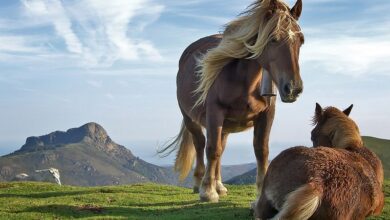All about the Tibetan Mastiff breed

Also known as the Tibetan Mastiff, the Tibetan Mastiff is a large and ferocious type of dog with a strong, arrogant and noble temperament. Among the most common characteristics of this breed is his alert mind, extreme loyalty, territorial awareness and hostility towards strangers, which is why many think that he is one of the best guard dogs.
The Tibetan Mastiff comes from Qinghai-Tibet, a cold area of China that is between 3,000 and 5,000 meters above sea level. It is considered the guardian dog and protector of the Tibetans, who know it as the tengu, due to the Chinese demon tiangou, which, according to legend, is a black mastiff or simply a giant mastiff that eats the moon during eclipses. For this reason, in the ancient East, the Tibetan mastiff is associated with the heroic deeds of a protector.
In Europe, during Roman times it was represented in the plastic arts as a formidable white Tibetan mastiff, where it appears in fights against lions, tigers, leopards and other ferocious animals. However, over the years, due to its grassland upbringing and poor awareness of protecting the bloodline on the part of herders, the original Giant Tibetan Mastiff has fused with other herding dogs, resulting in a hybrid. Tibetan shepherd very different from the old purebred.
physical characteristics of the breed
The harsh climatic conditions in the living environment have given the Tibetan Mastiff robust physical characteristics, making it a large dog with a tall body, well-proportioned build, strong bones and a large amount of muscle. Its head is large and wide and its coat is long, similar to that of a lion, which gives the Tibetan Mastiff a fairly high weight.
The ears are medium in size and V-shaped. In addition, they are naturally dropped and kept close to the front of the face. On the other hand, the mastiff’s eyes are medium in size and deep set, while the nose is wide and large. The legs are quite robust, muscular and have hairs between the fingers that give it a smooth appearance.

The behavior of the Tibetan mastiff
The Tibetan Mastiff’s mood is usually calm and even bored, as he prefers to lie in a doghouse (check this link for some purchase options) and watch his owner go about his daily chores. However, external stimuli or emotional arousal can cause dogs to feel joy, anger, sadness, happiness, or fear. The owner is usually able to recognize the emotions of the Tibetan dog based on the dog’s habitual behavior.
There are two main ways that dogs express their emotions: one is through action behavior and the other is through barking language. Action and bark expressions are often combined and presented at the same time, making it difficult to separate them. For example, the Tibetan mastiff will often bark attentively to inform the owner of a stranger or new person in the house, while she stands firmly watching the subject. In this case, the owner should let him know if it is a family friend, which helps reduce alertness.
It is important to mention that some dogs, especially untrained mastiff puppies, tend to growl while eating, demonstrating their ability to greedy and protect food. It is a time when the Tibetan mastiff is vulnerable, so it can show all its ferocity and attack people who come near its food. As with other breeds, the owner’s job is to make the dog understand that he is safe and his food is safe.
How to comb the hair of a Tibetan mastiff?
Hair should be combed once in the morning and once at night, for about 5 minutes each time. In this sense, you have to start from front to back and from top to bottom in sequence. That is, from the neck to the shoulders, then the back, the chest, the waist, the abdomen, the hindquarters and, finally, the extremities, including the tail.

Tibetan mastiff estrus and best mating day
Estrus is the period of heat in animals. In the case of the Tibetan Mastiff, it occurs twice a year, mainly in spring, from March to May, and in autumn, between September and November. In females, estrus is characterized by vaginal bleeding that generally lasts 21 days. However, in older females it can be much shorter, lasting just one or two days.
To increase the chances of conceiving, the first mating time is recommended on the tenth day of the bitch’s estrus. Afterwards, a daily mating is recommended until the 13th day of heat. When the female accepts the male Tibetan Mastiff for mating and the uterus is stimulated by sperm, ovulation begins 12-14 hours later, lasting approximately 48 hours.
The mastiff and its average life span is 10 to 14 years, making it a hardy dog. In addition, he stands out among the others for having an imposing and strong energy. Despite this, the Tibetan Mastiff and the different types of Mastiff are usually very loyal, as long as you establish a good relationship with them.
Finally, we can say that Tibetan mastiffs are great watchdogs, thanks to their robust physique and thunderous bark, which is why they are considered protectors par excellence.



